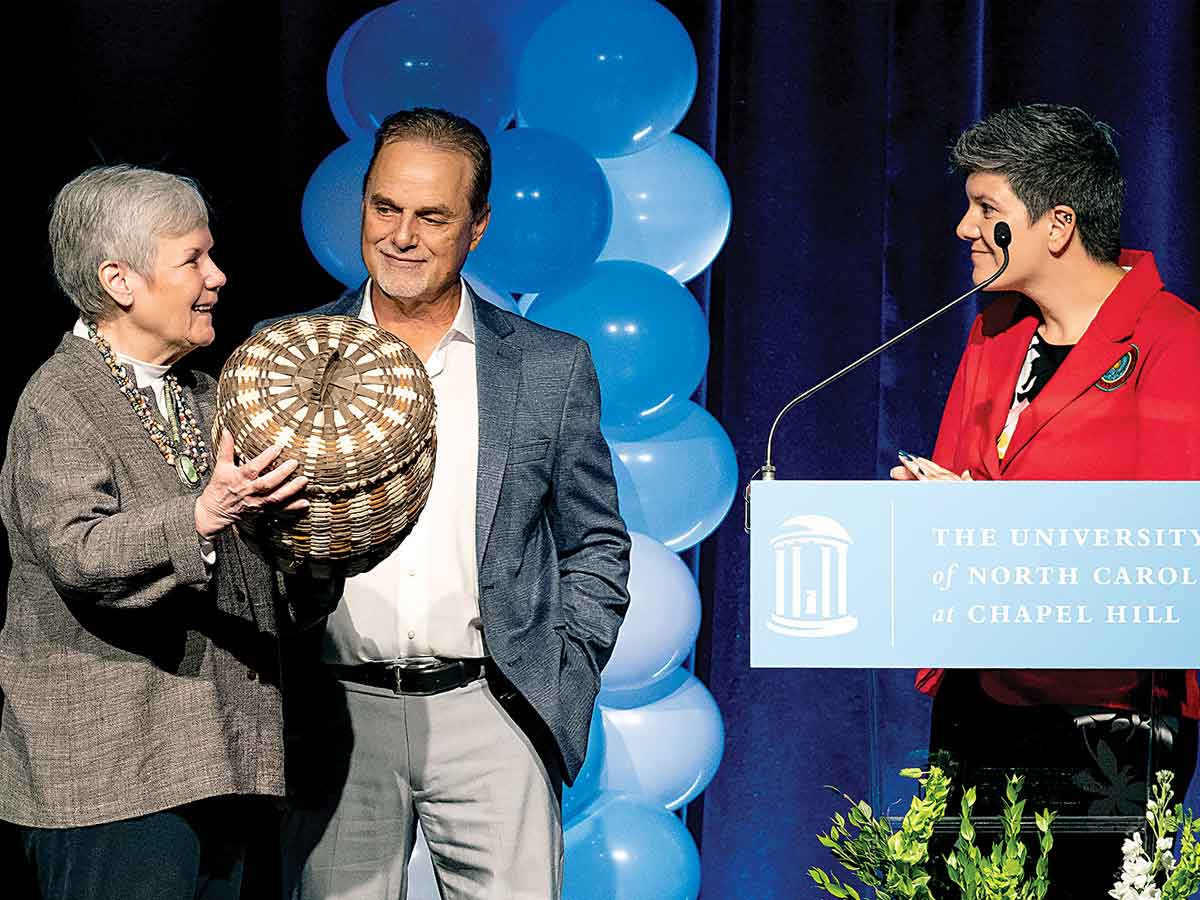UNC building renamed for Cherokee trailblazer
 Gladys Cardiff (left), daughter of Henry Owl, receives a gift from Eastern Band of Cherokee Indians Chief of Staff Ashleigh Stephens while sharing the stage with Tribal Council Rep. Boyd Owle at the dedication ceremony May 13. Jon Gardiner/UNC-Chapel Hill photo
Gladys Cardiff (left), daughter of Henry Owl, receives a gift from Eastern Band of Cherokee Indians Chief of Staff Ashleigh Stephens while sharing the stage with Tribal Council Rep. Boyd Owle at the dedication ceremony May 13. Jon Gardiner/UNC-Chapel Hill photo
Henry Owl was the first person of color, and the first Native American, to attend the University of North Carolina Chapel Hill. Now, 94 years after he first enrolled, a building has been named in his honor — on May 13, UNC’s student affairs building was officially christened the Henry Owl Building.
“At times, there’s been a fog around incredible, inspirational and underrepresented voices in our university’s history,” said Chancellor Kevin M. Guskiewicz. “And our goal today is to shine a light through that fog and illuminate more of the people who have made our university the place it is today.”
Born in 1896, Owl was a U.S. Army veteran and a graduate of Lenoir College, where he was elected “Most Popular Boy” and competed as a star athlete in football and baseball. In 1928, he enrolled at UNC Chapel Hill as a graduate student in history. Owl authored a study of Cherokee history that, told from his perspective as a Cherokee person, challenged racist myths that prevailed at the time. Later, he served as an educator in Bureau of Indian Affairs schools out west and relocated his family to Seattle, Washington, working as a counselor to Native American veterans of World War II and then as an inspector at Boeing Aircraft Company.
Owl also fought for the civil rights too often denied Native Americans of that era. In 1930, after earning his master’s degree, Owl appeared at the Ravensford election precinct in Swain County, where he asked to be registered to vote. In his hand, he held a copy of his master’s thesis, titled, “The Eastern Band of Cherokee Indians Before and After the Removal” to serve as proof, should it be required, that he was quite literate.
Despite a 1924 federal law granting Native Americans the right to vote , Owl was turned away. Precinct officials told him that he was a ward of the federal government, not a U.S. citizen, and therefore not eligible. Owl submitted a sworn account of the incident to the U.S. Senate’s Committee on Indian Affairs, which sped congressional approval of legislation affirming Cherokee suffrage, so long as they met state residency and literacy requirements. However, tribal members continued to face rejection at the polls until the federal Voting Rights Act passed in the 1960s.
Owl’s daughter, Gladys Cardiff, who lives in Seattle, attended the dedication ceremony, where she received a bound copy of his thesis. In public remarks, she said her father’s family respected education and expressed gratitude for the “high and conspicuous honor” of naming the building for him.
Related Items
“The significance of today goes far beyond any one name,” Cardiff said. “History is all about who speaks, who gets to speak and who does not.”
The building, completed in June 1900, was known as the Carr Building until 2020, when trustees voted to remove the name honoring Julian Shakespeare Carr.
A profile of Carr and his connection to UNC developed by UNC history students bears the title, “The most generous white supremacist.” Carr is the only person to have served on the Board of Trustees at both UNC Chapel Hill and Duke University, and he gave large contributions to both schools. He is also known for his stridently racist views, especially as expressed during the fiery speech he gave at the dedication of the now-infamous Silent Sam statue. In that speech, he described the “pleasing duty” he once had of horse-whipping a Black woman in front of 100 Federal soldiers, “one hundred yards from where we stand.”
Replacing Carr’s name with Owl’s will “affirm the principles of democracy, justice and equality that defined his life and career,” reads a statement from the Chancellor’s Advisory Committee on Naming University Facilities and Units.
Owl is not the first EBCI member to serve as a UNC building’s namesake. Last year, UNC Asheville renamed Ashe Hall for Ella Bird , one of three living Beloved Women in the tribe. On the same day that Owl’s name was honored, UNC Chapel Hill renamed another building, the former Aycock Residence Hall , for the university’s first Black professor, Hortense McClinton .









